Increasing My Hyacinthal Holdings
/3 Comments/in Flowers, Gardening/by Lee ReichHyacinth City
I’ve admitted this before; here’s more evidence of my addiction — to propagating plants. I currently have a seed flat that’s only 4 by 6 inches in size and is home to about 50 hyacinth plants. Obviously, the plants are small. But small and sturdy.
The genesis of all these plants goes back a couple of years when I needed photos for my book The Ever Curious Gardener: Using a Little Natural Science for a Much Better Garden. For the chapter on some aspects of the science of plant propagation and the practical application of that science, I made photos of some methods of multiplying hyacinth bulbs. Here’s an excerpt of that section:
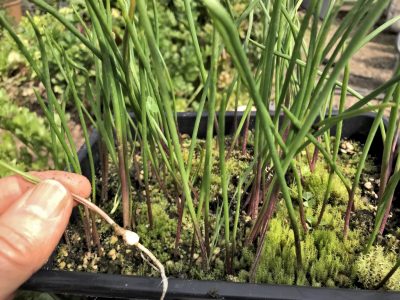 “Knowing what a bulb really is makes it easier to understand how they can multiply so prolifically that their flowering suffers, and how to get them to multiply for our benefit. Dig up a tulip or daffodil and slice it through the middle from the tip to the base. What you see is a series of fleshy scales, which are modified leaves, attached at their bases to a basal plate, off of which grow roots—just like an onion (but, in the case of daffodil, poisonous!). The scales store food for the bulb while it is dormant.
“Knowing what a bulb really is makes it easier to understand how they can multiply so prolifically that their flowering suffers, and how to get them to multiply for our benefit. Dig up a tulip or daffodil and slice it through the middle from the tip to the base. What you see is a series of fleshy scales, which are modified leaves, attached at their bases to a basal plate, off of which grow roots—just like an onion (but, in the case of daffodil, poisonous!). The scales store food for the bulb while it is dormant.
That bottom plate is the actual stem of the plant, a stem that has been telescoped down so that it’s only about a half-inch long. Those fleshy scales are what store food for the bulb, and, depending on the kind of bulb, are nothing more than modified leaves or the thickened bases of leaves.
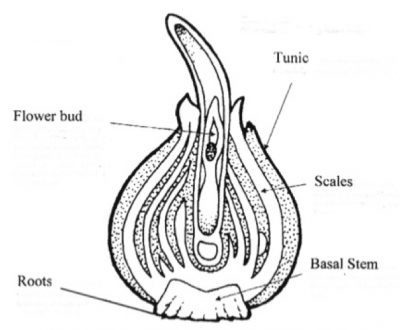 Look at where the leaves meet the stems of a tomato vine, a maple tree—any plant, in fact—and you will notice that a bud develops just above that meeting point. Buds likewise develop in a bulb where each fleshy scale meets the stem, which is that bottom plate. On a tomato vine, buds can grow to become shoots; on a bulb, buds can grow to become small bulbs, called bulblets. In time, a bulblet graduates to become a full-fledged bulb that is large enough to flower.”
Look at where the leaves meet the stems of a tomato vine, a maple tree—any plant, in fact—and you will notice that a bud develops just above that meeting point. Buds likewise develop in a bulb where each fleshy scale meets the stem, which is that bottom plate. On a tomato vine, buds can grow to become shoots; on a bulb, buds can grow to become small bulbs, called bulblets. In time, a bulblet graduates to become a full-fledged bulb that is large enough to flower.”
Natural Increase
“Let’s see just how the big three flowering bulbs—tulips, daffodils, and hyacinths—grow. With tulips, the main bulb, the one that flowers, disintegrates right after flowering and is replaced by a cluster of new bulblets or bulbs. The mother bulb of a daffodil continues to grow after flowering, at the same time producing offsets of bulbs or bulblets which may remain attached to the mother bulb. Hyacinths grow the same way as daffodils, except for being much more reluctant to make babies.
All those bulblets and bulbs can, in time, crowd each other for light, food, and water, so flowering suffers. When my daffodils, tulips, or hyacinths seem to be making too many leaves and too few flowers, I know it’s time to dig them up and separate all the bulbs and bulblets. The best time for this operation is just as the foliage is dying back in spring or early summer because after that plants are out of sight until the following spring. Replanting can be done immediately or delayed until autumn.”
The Scoop on Propagating Bulbs
“Knowing something about bulb structure also gives me inside information on how to multiply my holdings faster, perhaps to make enough plants for a whole field or a giant flower bed. Merely digging up and planting offsets is one way of doing this. Also, knowing that the bottom plate is a stem and that the offsets come from side buds lets me coax those side buds to grow just as can be done with any other stem.
Pinching out the growing tip of any stem makes side buds grow. One way you get rid of, or ‘pinch out,’ the growing tip of a bulb is to turn the bulb upside down, then scoop out the center of the bottom plate with a spoon or knife.  Another way is to score the bottom plate with a knife into 6 pie shaped wedges, making each score cut deep enough to hit that growing point.
Another way is to score the bottom plate with a knife into 6 pie shaped wedges, making each score cut deep enough to hit that growing point.  After scoring or scooping, set the bulb in a warm place in dry sand or soil for planting outdoors in a nursery bed in autumn.
After scoring or scooping, set the bulb in a warm place in dry sand or soil for planting outdoors in a nursery bed in autumn. After a year, as many as 60 bulblets might be sprouting from the base of each scooped or scored bulb. Each bulblet does take 4 or 5 years to reach flowering size, but no matter. To quote an old Chinese saying: ‘The longest journey begins with the first step.’”
After a year, as many as 60 bulblets might be sprouting from the base of each scooped or scored bulb. Each bulblet does take 4 or 5 years to reach flowering size, but no matter. To quote an old Chinese saying: ‘The longest journey begins with the first step.’”
My little hyacinth bulblets are now in their second season of growth. I’ll keep them growing strongly until their leaves yellow as they go naturally dormant, probably late this spring. Come fall, I’ll dig them all out, separate them, and then plant them out in a nursery bed or else in their permanent homes. I expect aromatic bliss in a couple of years.
And, On Another Note
I was recently a guest on Susan Poizner’s radio show/podcast where we talked about growing uncommon fruits, here at my farmden and in general. Hear it at https://orchardpeople.com/growing-uncommon-fruits/
A Farmdener, That’s Me
/16 Comments/in Design, Flowers, Fruit, Gardening, Vegetables/by Lee ReichA New Word is Introduced
I’d like to introduce the words farmden and farmdener into the English language. I wonder if there are any other farmdeners out there.
What is a farmden? It’s more than a garden, less than a farm. That’s my definition, but it also could be described as a site with more plants and/or land than one person can care for sanely. A gardener and garden gone wild, out of control.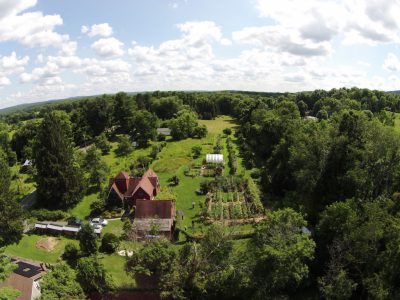
You might sense that I speak from personal experience. I am. My garden started innocently enough: A 30 by 40 foot patch of vegetables, a few apple trees, some flowers, and lawn. That was decades years ago, and in the intervening period, the lawn has grown smaller, the vegetable garden has doubled in size, and the fruit plantings have gone over the top.
Originally, I had less than acreage – 72 hundredths of an acre to be exact. But over the course of 15 years, I did manage to put my fingers onto almost every square foot of that non-acre. Squeezed into that area were 40 varieties of gooseberries, a dozen varieties of apples, a half dozen varieties of grapes, red currants, white currants, black currants, raspberries, mulberries: you get the picture. All that, in addition to my vegetables, flowers, and some shrubbery. But I was still not a farmdener, and my property was not a farmden.
Evolution of My Farmden
The transition from garden to farmden occurred with the purchase of a fertile acre-and-a-half field bordering the south boundary of my property.
With that purchase, I expanded my plantings, rationalizing that because I write about gardening (for magazines, for Associated Press, and for this blog) and host workshops here, I should test and grow a lot of what I write and talk about. So instead of 2 hardy kiwifruit vines such as any normal gardener might grow, I planted 20 vines of a few species and varieties. Instead of 2 pawpaw trees, à la normal gardener, I planted 20 pawpaw trees of few varieties.

Pawpaws, blackcurrants, and hardy kiwis
And how about another dozen apple trees? And chestnuts, filberts, pine nuts (Pinus koreansis is hardy here in New York’s Hudson Valley). Again, you get the picture.
But no, I wasn’t finished. There was always one more plant needing a home, one more piece of ground hungry for a plant. Why not create another vegetable garden; after all, I had just gotten married, and that made another mouth to feed. Why buy vegetables when you have enough land to grow them?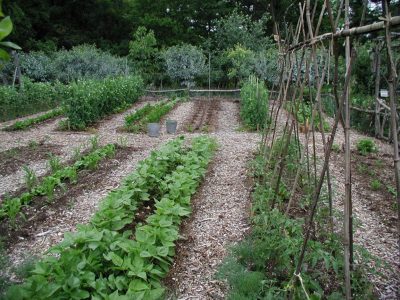 And what about winter? A greenhouse full of salad and cooking greens solved that problem, in addition to providing figs in summer and early and late season cucumbers.
And what about winter? A greenhouse full of salad and cooking greens solved that problem, in addition to providing figs in summer and early and late season cucumbers.
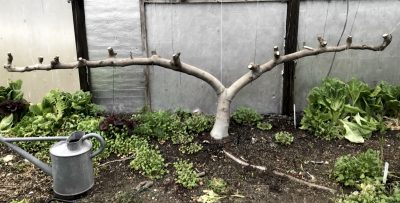
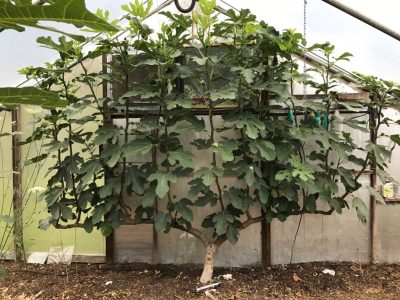
I like crown imperial (Fritillaria imperialis) flowers and learned the quirks of propagating them – pack pieces of bulb scales in moist potting soil and subject them to a few months of warm temperatures, then a few weeks of cool temperatures, pot up, plant out. Soon I had not a crown imperial or two such as you might find in most gardens, but dozens of them, and more still coming on.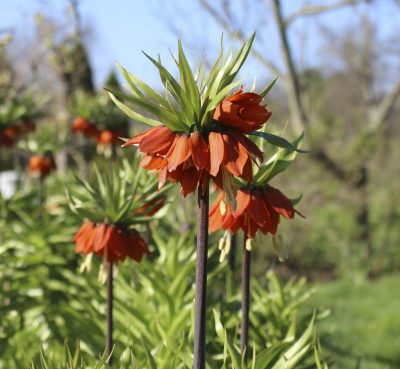
You might imagine that, despite my plantings, my lawn still grew bigger with that increased acreage. Not so. Most of the acre and a half, except what was devoted to new plantings, became a hayfield that I mowed and helped feed my compost pile. A bit of rationality prompted me to graduate from scything to a small farm tractor for brush hogging that field. (Tennis elbow, the result of excessive scything, also helped with that decision. But I still use the scythe, a high quality Austrian style scythe, to mow parts of the field.)
Present and Future
What I now had – and have – is a farmden. And I am a farmdener. A farmden is not something from which you can earn a living, although I have sold some excess pawpaws, American persimmons, and hardy kiwifruits, mostly for test marketing in my efforts to see whether these fruits are worth promoting for small farms. (They are; flavor sells.)
And my farmden is a great venue for workshops, as long as I point out that participants should pay attention to my plants, not the number of them, because my property is obviously the handiwork of a crazed gardener (or a sane farmdener?). “Don’t try this at home,” I tell participants right off the bat.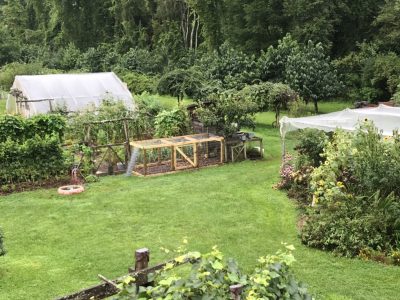
I do occasionally still garden. Right next to my terrace is a bed with tree peonies, potentiillas, clove currants, and Signet marigolds, all well-contained by the bricks of the terrace on one side and a low, moss-covered hypertufa wall on the other side. The bed is close to the house and the bed is small. Yesterday I noticed weeds starting to overstep their limit in the bed. I crouched down, started at one side of the bed, and gave it a thorough weeding, literally getting my hands on every square inch of soil. It was fun and it was quick.
Most of my time, though, is spent farmdening. It’s very satisfying, even if it does get crazy sometimes, and it yields a cornucopia of very tasty and healthful fruits and vegetables, many of them planted with an eye to beauty as well as function.
I have vowed not to plant anything more in the hayfield, in large part because it’s so pretty, the soft violet hue from midsummer’s monarda flowers grading over into a golden glow from late summer’s goldenrods. I also promised my daughter, when she was young and enthralled with Laura Ingalls Wilder, that we would leave most of the field as “prairie.” (Now over 30 years old, my daughter no longer yearns for prairies, but I’m keeping my promise.)
I have taken some of the edge off the transition from gardening to farmdening with some help here on the farmden from an occasional helper. Still, I am planning to keep the “den” in farmden.
Down in Dixie
/3 Comments/in Flowers, Fruit/by Lee ReichGreen, Green, Green, and Flowers!
After delivering a couple of lectures about gardening in North Carolina, I set off on a very short, whirlwind tour of the southeast, specifically North Carolina and Georgia, and ending with a stay in Charleston. How different from my spot here in New York’s Hudson Valley!
For all Charleston’s uniqueness, three characteristics jumped out. It being early March and my coming an achromatic landscape of snow, sleeping plant life, and cold, I was immediately struck by the abundance of greenery. Not the tired greenery of many evergreens here in the north, but vibrant, awake greenery in a variety of shapes, textures, and sizes.

Camellia blossoming in Charleston
Included in all that Charlestonian greenery were fronds of palm trees — saw palmetto and sabal palmetto — fanning out above jagged trunks. Those palms were a reminder that I was now in a subtropical rather than temperate climate. Not that the weather helped make the point; some days were in the high 40s and one night temperatures were predicted to dip near freezing.
March notwithstanding, Charleston had no dearth of flowers. Camellia blossoms stared out from a backdrop of their verdant foliage. Camellia is one of my favorite plants. I tried to grow one of the hardier new varieties of camellia a few years ago, offering it some cold protection by planting it near my home; it died its first winter. I wonder if southerners become blasé about these blossoms; camellias were growing everywhere, and in bloom.
The white blossoms of sweet osmanthus belied their diminutive size with the strength with which they perfumed the air. The fragrance was fruity, apricot.
Very different was another fragrance, this one wafting from clusters of trumpet-shaped blossoms dangling from the bare stems of edgworthia, also known as paperbush. That’s another plant that won’t grow this far north but no matter. I wavered between enjoying and not enjoying its resinous aroma.
If only gardenias — another plant growing outdoors in the southeast but not hardy here in the North— had been in bloom, the olfactory part of my trip would have been complete. All I could do was marvel at what it would be like if I could have a dooryard shrub of gardenia. I might be on the verge of passing out as I hyperventilated through the bloom season.
Oranges? No. ‘Quats? Yes
Two interesting fruits turned up here and there.
One was loquat, an odd relative of apple and pear. The leaves are large, dark green, and evergreen with a matte finish, all of which makes an appearance that is subtropical, which the plant is.
Most odd is loquat’s bearing habit. It flowers in autumn and ripens its fruit in spring or early summer. I once bought one at a fruit stand in Paris. Its flavor was unimpressive, but that’s true of many commercially marketed fruits. Loquats generally receive high praise for flavor. If I ever get to taste a good one, I might grow the plant in the loquat-perfect environment of my greenhouse.
The other fruit was citrus, two fruits, actually, and also “-quats” but not at all related to kumquat. They were kumquat and citrangequate. It just didn’t seem like citrus could be hardy that far north (except for the super-cold-hardy but hardly edible trifoliate orange, which I have growing outdoors).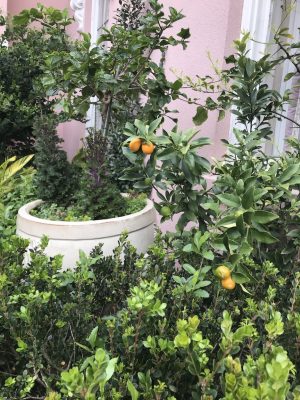 But winter low temperatures in Charleston rarely dip even to freezing but kumquat trees are hardy into the ‘teens. A few citrangequats — trigeneric hybids of kumquat, trifoliate orange, and sweet orange — that I stole from a tree proved to be tasty with sweet, edible rind enclosing a pleasingly tart interior.
But winter low temperatures in Charleston rarely dip even to freezing but kumquat trees are hardy into the ‘teens. A few citrangequats — trigeneric hybids of kumquat, trifoliate orange, and sweet orange — that I stole from a tree proved to be tasty with sweet, edible rind enclosing a pleasingly tart interior.
Southern Faves
Three of my favorite plants that I cannot grow were present in abundance. I already mentioned camellia. Another is southern magnolia, a stately tree that differs from northern magnolia in having very large, leathery, evergreen leaves that look somewhat like the rubber trees that are common houseplants.
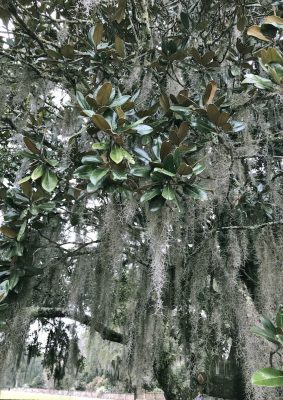
Southern magnolia decked with Spanish moss
It was too early for the large, white, fragrant blossoms to appear but I would grow the tree for the leaves alone, if I could. It’s almost hardy here; I’ve seen trees in northern New Jersey.
Another favorite is a deciduous plant also almost cold-hardy here: crape myrtle. The plants are decked with bright flowers in various shades of red all summer, but are bare of leaves or flowers in winter, even in South Carolina. No matter, crape myrtle has a mottled, shedding bark that puts on a good show when its flowers are offstage.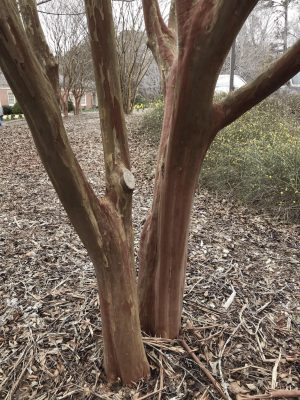
And A Dark Cloud
A dark cloud that hangs over Charleston is its role in the slave trade. About 40% of all slaves entering America entered through Charleston. And it’s not just a statistic like this or a visit to the Slave Museum, site of one of Charleston’s many slave auctions, that recalls the horrors of human bondage. I couldn’t help, when visiting the plantations in and near Charleston, constantly reminding myself that they were only possible with the labor of enslaved humans. Reminders are everywhere; even the bricks of the buildings right in town were hand made by slaves.
Many of the slaves auctioned off in Charleston were separated from their families and transported to other sites throughout the colonies, making all the colonies and then states culpable.

